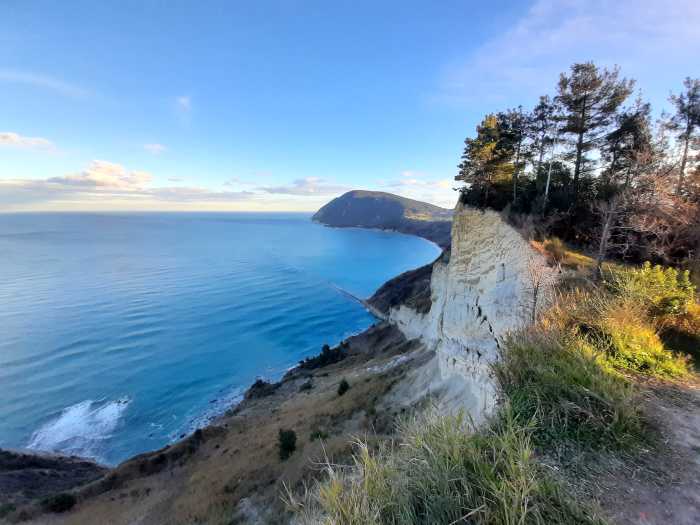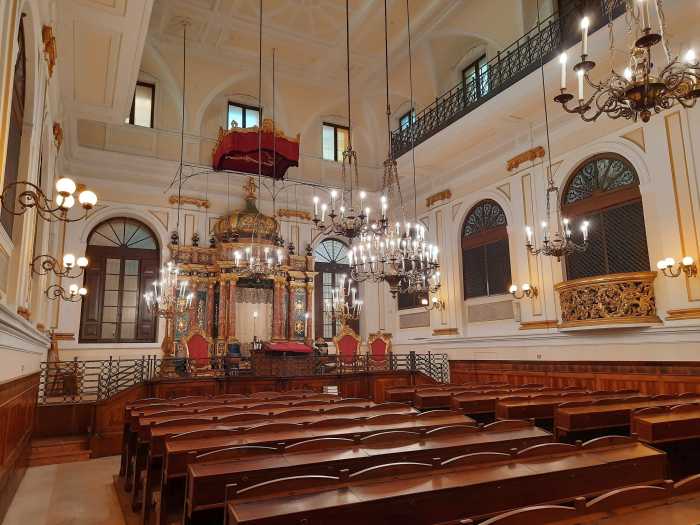
Conero Riviera
This is a lovely region located in central Italy between the Apennines and the Adriatic Sea. It enjoys a very varied landscape with beautiful mountains and rolling hills, medieval and renaissance towns and villages perched on top of them, natural attractions and a very inviting coastline along the Adriatic sea. In addition, the Jewish Communities of the Marche region have a very old history and today I will bring you to visit its main Jewish heritage sites.
In doing so, I will also accompany you through a region that was at the center of the Papacy’s temporal power and of all the struggles, alliances, and their many and sudden shifts unparalleled in any other Italian regions. As a proof of this, only in the Marche can you see engravings in the main piazza of every hamlet, village, and town proudly stating how freedom was won from the Church’s temporal oppressive rule.

Ancona's Italian Synagogue
Ancona
We start the Jewish itinerary of the Marche region from its main city: Ancona. The Jewish community of Ancona is one of the oldest and most significant Jewish communities in Italy. The presence of Jews is first recorded in the 10th century. In the following centuries the community grew because of the importance of the port and commercial links with the Levant. Here, as in all the territories under the Papacy’s temporal power, a ghetto was established in the year 1555, the 2nd largest in central Italy after the one in Rome. In 1848 the ghetto was abolished and a new urban plan remodeled the area of the ghetto, except for the areas of Via Astagno and Via del Bagno, where one can find the two remaining synagogues of Ancona, the Levantine Synagogue and the Italian Synagogue.
After your visit to the synagogues, you can head over to the Ancient Jewish Cemetery, also known as “Campo degli Ebrei”, literally “Field of the Jews”. It is located between Cappuccini Hill and Mount Cardeto and is one of the largest and best preserved Jewish cemeteries in Europe. It features 178 tombstones with Jewish inscriptions dating from the 15th to the 19th century, which are all facing Jerusalem. Not far away from the Jewish cemetery stands the Lighthouse, an attraction off the main tourist path, but a favorite of a local like me. From here you can enjoy breathtaking views of the city, the Adriatic Sea and the port.
After your visit to the synagogues, you can head over to the Ancient Jewish Cemetery, also known as “Campo degli Ebrei”, literally “Field of the Jews”. It is located between Cappuccini Hill and Mount Cardeto and is one of the largest and best preserved Jewish cemeteries in Europe. It features 178 tombstones with Jewish inscriptions dating from the 15th to the 19th century, which are all facing Jerusalem. Not far away from the Jewish cemetery stands the Lighthouse, an attraction off the main tourist path, but a favorite of a local like me. From here you can enjoy breathtaking views of the city, the Adriatic Sea and the port.

Ancona's Levantine Synagogue
We now begin our descent to the harbor area with its special attractions, the Arch of Trajan, the Mole Vanvitelliana and Porta Pia, one of the main gateways of Ancona. Last but not least, I will introduce you to The Passetto, Ancona’s emerald treasure, a green park in an extraordinary panoramic position overlooking the sea and the Conero. The Passetto has magnificent stairways that descend to the sea, allowing you to reach the sea on foot, which is only a few minutes walking distance from Ancona’s historic center.
At this point I suggest a nice and relaxing stop along the beautiful Conero coastline which we had just admired from the lighthouse. Its white cliffs and pristine beaches in contrast with the cobalt blue waters of the Adriatic Sea are impossible to resist. Pick a lido of your choice, rent an umbrella with a couple of sun beds to relax on and enjoy after a refreshing swim.


Pesaro's Synagogue
Urbino
The following day I will take you to stunning Urbino with its perfectly preserved city center which is a joy to walk through and its incredible Palazzo Ducale that inspired one of the most epic scenes in the “Star War” saga. Urbino was one of the most important cities during the Renaissance era, mostly thanks to its Lord Federico di Montefeltro. In the second half of 1400, he strived to reorganize Urbino in order to create a modern, rational and beautiful city. This beautiful city is also the birthplace of the famous painter Raphael.
The Jewish presence in Urbino dates back to the XIV century when the Duke Federico di Montefeltro, distinguished for his liberal policy towards the Jews, welcomed them to settle within the boundaries of the Duchy and to establish trade there. During his rule the Jewish community had the same rights and privileges as the Christians. However, with the death of the last Montefeltro all this came to an abrupt end because the papal anti-Jewish legislation was applied in Urbino too. The Papacy’s anti-Jewish stand was reflected in the works of some artists of the time. For example, Paolo Uccello’s the Miracle of the Desecrated Host currently on display in the Palazzo Ducale of Urbino. From that moment, the Jewish community was forced to move to a ghetto where it built its synagogue that is still standing today. Like Ancona, Urbino also hosts a Jewish cemetery located in a very panoramic area of the town.
The following day I will take you to stunning Urbino with its perfectly preserved city center which is a joy to walk through and its incredible Palazzo Ducale that inspired one of the most epic scenes in the “Star War” saga. Urbino was one of the most important cities during the Renaissance era, mostly thanks to its Lord Federico di Montefeltro. In the second half of 1400, he strived to reorganize Urbino in order to create a modern, rational and beautiful city. This beautiful city is also the birthplace of the famous painter Raphael.
The Jewish presence in Urbino dates back to the XIV century when the Duke Federico di Montefeltro, distinguished for his liberal policy towards the Jews, welcomed them to settle within the boundaries of the Duchy and to establish trade there. During his rule the Jewish community had the same rights and privileges as the Christians. However, with the death of the last Montefeltro all this came to an abrupt end because the papal anti-Jewish legislation was applied in Urbino too. The Papacy’s anti-Jewish stand was reflected in the works of some artists of the time. For example, Paolo Uccello’s the Miracle of the Desecrated Host currently on display in the Palazzo Ducale of Urbino. From that moment, the Jewish community was forced to move to a ghetto where it built its synagogue that is still standing today. Like Ancona, Urbino also hosts a Jewish cemetery located in a very panoramic area of the town.

Urbino's Ducal Palace
Stay tuned, for the coming attractions in the Marche region. As in the near future you will hear more and more about this region so close to Tuscany and Umbria!
Pietro Migliori from La Tour I-Talya. LaTour I-Talya is a project established and managed by a team of Italian Jews working together with one of the largest and most prestigious Italian Tour Operators. LaTour I-Talya specializes in tour packages which focus on the amazingly rich Jewish historical and cultural heritage found throughout Italy.
Read more articles from our Hidden Gems of Italy series:
Echoes of the Past: Unraveling Trieste's Jewish Legacy
A Walk Through History: Exploring Ferrara's Jewish Heritage
Beyond Rome: The Enchanting Villages of Anagni and Alatri
Explore the Charm of Casate Monferrato
Get in Touch with the oldest Jewish community in Tuscany
The Jewish beauty of Florence
Mantua: First stop in the Renaissance cities of Northern Italy
Pitigliano: "Little Jerusalem" in the Tuscan Maremma Region
Cividale del Friuli: Jewish Tours of Italy off the Beaten Path
The Charming Padova (Padua)
Pietro Migliori from La Tour I-Talya. LaTour I-Talya is a project established and managed by a team of Italian Jews working together with one of the largest and most prestigious Italian Tour Operators. LaTour I-Talya specializes in tour packages which focus on the amazingly rich Jewish historical and cultural heritage found throughout Italy.
Read more articles from our Hidden Gems of Italy series:
Echoes of the Past: Unraveling Trieste's Jewish Legacy
A Walk Through History: Exploring Ferrara's Jewish Heritage
Beyond Rome: The Enchanting Villages of Anagni and Alatri
Explore the Charm of Casate Monferrato
Get in Touch with the oldest Jewish community in Tuscany
The Jewish beauty of Florence
Mantua: First stop in the Renaissance cities of Northern Italy
Pitigliano: "Little Jerusalem" in the Tuscan Maremma Region
Cividale del Friuli: Jewish Tours of Italy off the Beaten Path
The Charming Padova (Padua)